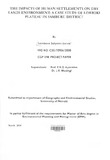| dc.description.abstract | Natural factors like frequent droughts as consequence of weather variability bring about vegetation change. Ecosystems are only capable to recover from such perturbations, if human activities are controlled and sustainable utilization of natural resources is adopted. Vegetation changes, as a result of human orchestrated land uses that bring about permanent settlement, regular and concentration of human population in one location. Lorroki plateau is not inimitable from such perturbations. Such perturbations have had negative impacts to the local livelihoods, affecting the food security situation, access to water, pasture and occasionally causing natural resource base conflicts, due to competition.
The objective of the study was to identify and describe the impacts of human settlement on the dry land environment of Lorroki plateau, and draw the appropriate recommendations for sound policies and decision making. Ten settlements adjacent to the western part of Lorroki forest reserve were sampled. Multistage sampling technique was used that included; interviewing ten households per settlement, one focus group discussion per settlement, and sixty quadrant plots measuring 1 OOx 100m within the settled and control area were developed. Inventory of cedar and olive trees taken plus the measurements of diameters at breast height (DBH) for the two tree species within the plots, Soils samples from each plot were collected and delivered to soil labs Kabete for complete analysis. Data analysis was done by use of SPSS and MS-EXCEL sheets that enabled quantitative and qualitative statistical techniques.
Research findings revealed that human activities around the settlements have had negative impacts to the environment and most importantly the vegetation cover, where cedar and olive tree species were found to be the most endangered among the other biological resources. Deforestation of the two tree species were 16% higher around the human settlements as compared to the control area. Correlation analysis indicates strong positive correlation between the DBH and soils organic matter while the regression is non-linear. Deficiencies in soil macro-nutrients including nitrogen, potassium, and phosphorus were observed, more evidently around the human settlements.
In conclusion human settlement continues to impact negatively on Lorroki ecosystem, confirming the Malthusian theory on population and land use. The research recommends the need to mainstream environmental management strategies into the development process in Lorroki plateau. Promotion of sustainable utilization of natural resources is of paramount importance, in reversing the current utilization patterns. | en_US |

